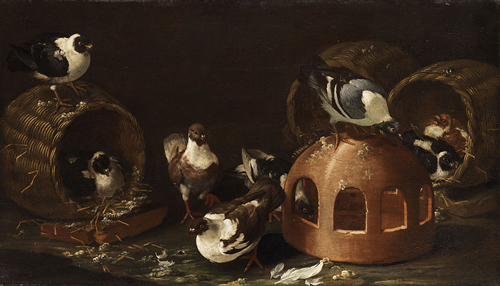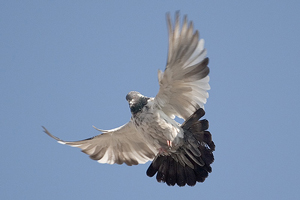
Source: Giovanni Agostino Cassana Tauben zwischen Körben, Wikimedia
Caged or cooped-up birds are also the subject of the next section of this lesson on themes. In Doris Lessing’s short story, “Flight,” a grandfather keeps homing pigeons in a cage, called a dovecote, in his backyard. He releases all the pigeons to fly about and then return home, except for his favorite, because he is worried it might not return. Another object of the grandfather’s overprotective love is his youngest granddaughter, Alice. She is dating Steven, and the grandfather is worried that she will marry and leave home. He shares his concern with his daughter, who is Alice’s mother. Read his daughter’s sensible response.
'Come, now, Dad. She'll be down the road, that's all. She'll be here every day to see you.' 'But it's not the same.' He thought of the other three girls, transformed inside a few months from charming petulant spoiled children into serious young matrons. 'You never did like it when we married,' she said. 'Why not? Every time, it's the same. When I got married you made me feel like it was something wrong. And my girls the same. You get them all crying and miserable the way you go on. Leave Alice alone. She's happy.' She sighed, letting her eyes linger on the sunlit garden. 'She'll marry next month. There's no reason to wait.'
When his plea to his daughter doesn’t work, the old man returns to the backyard and is surprised by a gift.
From around the corner came the young couple; but their faces were no longer set against him. On the wrist of the postmaster's son balanced a young pigeon, the light gleaming on its breast. 'For me?' said the old man, letting the drops shake off his chin. 'For me?' 'Do you like it?' The girl grabbed his hand and swung on it. 'It's for you, Granddad. Steven brought it for you.' They hung about him, affectionate, concerned, trying to charm away his wet eyes and his misery. They took his arms and directed him to the shelf of birds, one on each side, enclosing him, petting him, saying wordlessly that nothing would be changed, nothing could change, and that they would be with him always. The bird was proof of it . . .
Now watch a dramatization of this short story.

Source: Pigeon Flying 004, Jehanzeb Khan, Flickr
The new pigeon has not yet learned there “is no place like home.” The grandfather will have to train it as he has the others in the kit, which is the collective name for a group of pigeons. Read what happens next in the story.
They had forgotten him again. Well, so they should, the old man reassured himself, feeling his throat clotted with tears, his lips trembling. He held the new bird to his face, for the caress of its silken feathers. Then he shut it in a box and took out his favourite. (favorite)
'Now you can go, he said aloud. He held it poised, ready for flight, while he looked down the garden towards the boy and the girl. Then, clenched in the pain of loss, he lifted the bird on his wrist, and watched it soar. A whirr and a spatter of wings, and a cloud of birds rose into the evening from the dovecote.
The theme of Doris Lessing’s short story is not stated explicitly like the moral in a fable. Instead, readers are expected to think about the author’s clues and make an educated guess about the implicit theme. The title of the story “Flight” is a good place to begin. One of the definitions for the word “flight” in the Merriam-Webster dictionary is the “act of running away.” You can tell from the story that the grandfather was afraid his favorite pigeon might fly away and that his youngest granddaughter Alice might run away. So perhaps the multiple meanings of the title word “Flight” provide a connection between the grandfather’s two fears and the theme.
Now using the clues in the Plot Summary and the text, answer the following questions related to the theme. Click on the answer that you think is correct.
